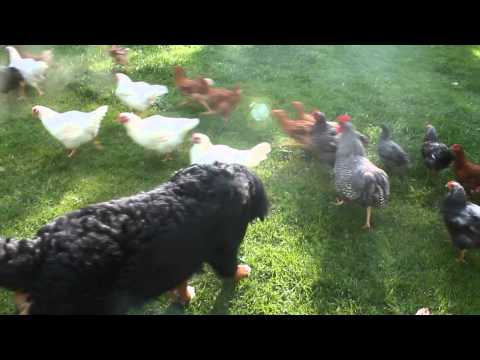It seems that the more things change the more that they remain the same. In the 1940s and 1950s my family and I raised pastured broilers. It was quite commend then to see 10, 20, 40, and 80 acres or even larger broiler pastures dotted across the country side. These poultry pastures were divided, fenced, and cross fenced into smaller paddocks and each paddock had a moveable roost shelter.
One problem was aerial predators. I know this because my first job as an up and coming chicken farmer was to sit on a milk crate on my granddaddy's chicken farm with a 20 gage single barrel shot gun on my lap and a hand full of shells in my pocket. The purpose of the "shooting iron" was to "scare" off the chicken hawks. Then there was those other wild birds. I'm speaking about sparrows, starlings, blackbirds, grackles, and other members of the chicken feed stealing tribe who spread fowl mites, lice, and practically every avian disease and internal parasite known to chicken or man. As you can seen pastures are not the perfect or ideal way to farm chickens, far from it.
Now mind you, at this time poultry science had just made it into the big time, and previously pastured poultry was the only way to farm or keep many chickens alive lone enough for them to grow to market size. But even then pastured poultry was dying out as a way to farm chickens. Soon granddad built his first chicken house. At this time the federal minimum wage was a quarter per hour and grocery store chicken cost about the same 25 cents per pound. Now even with todays soaring prices, a fully dressed or processed chicken can still be bought by working less than an hour for minimum wage pay. Before it took half a day of minimum wage labor to buy one New York dressed chicken that sold per pound complete with the feet, head, and guts intact. There had to be a reason that in the past politicians promised America "TWO chickens in every pot", it was because at that time chicken was an out of reach luxury for the vast majority of Americans.
I do know this for a certainty, those who would use a gun to stop you and me from eating chickens and eggs have nothing to loose and everything to gain when grocery store chicken goes to $20 per pound and that Sunday fryer at Krogers cost $100 or more. Meaning that a KFC bucket of original recipe fried chicken with the fixing would go for $500 to a $1,000 dollars a pop. This is not about helping chickens it is about hurting consumers especially the poorest ones by using the power of the state to foment discontent and starvation or to kill corporations by putting the cost of food beyond the means of the poor.
The reason this pastures were used to grow chickens was because there were few if any antibiotics, vaccines, and other medicines or knowledge about how to grow chickens on a large scale especially inside of a building. In the main it just couldn't be done not with chickens, hogs, or dairy cows. Now days the same number of chickens ready for market that once required a 1/2 mile by 1/4 mile pasture to produce can be produced in a couple of 400 X 40 foot chicken houses, they can be produced in fewer days, on a smaller amount of feed, with a higher survival rate, and with less labor than any obsolete poultry pasture past or present could ever hope to do.
One problem was aerial predators. I know this because my first job as an up and coming chicken farmer was to sit on a milk crate on my granddaddy's chicken farm with a 20 gage single barrel shot gun on my lap and a hand full of shells in my pocket. The purpose of the "shooting iron" was to "scare" off the chicken hawks. Then there was those other wild birds. I'm speaking about sparrows, starlings, blackbirds, grackles, and other members of the chicken feed stealing tribe who spread fowl mites, lice, and practically every avian disease and internal parasite known to chicken or man. As you can seen pastures are not the perfect or ideal way to farm chickens, far from it.
Now mind you, at this time poultry science had just made it into the big time, and previously pastured poultry was the only way to farm or keep many chickens alive lone enough for them to grow to market size. But even then pastured poultry was dying out as a way to farm chickens. Soon granddad built his first chicken house. At this time the federal minimum wage was a quarter per hour and grocery store chicken cost about the same 25 cents per pound. Now even with todays soaring prices, a fully dressed or processed chicken can still be bought by working less than an hour for minimum wage pay. Before it took half a day of minimum wage labor to buy one New York dressed chicken that sold per pound complete with the feet, head, and guts intact. There had to be a reason that in the past politicians promised America "TWO chickens in every pot", it was because at that time chicken was an out of reach luxury for the vast majority of Americans.
I do know this for a certainty, those who would use a gun to stop you and me from eating chickens and eggs have nothing to loose and everything to gain when grocery store chicken goes to $20 per pound and that Sunday fryer at Krogers cost $100 or more. Meaning that a KFC bucket of original recipe fried chicken with the fixing would go for $500 to a $1,000 dollars a pop. This is not about helping chickens it is about hurting consumers especially the poorest ones by using the power of the state to foment discontent and starvation or to kill corporations by putting the cost of food beyond the means of the poor.
The reason this pastures were used to grow chickens was because there were few if any antibiotics, vaccines, and other medicines or knowledge about how to grow chickens on a large scale especially inside of a building. In the main it just couldn't be done not with chickens, hogs, or dairy cows. Now days the same number of chickens ready for market that once required a 1/2 mile by 1/4 mile pasture to produce can be produced in a couple of 400 X 40 foot chicken houses, they can be produced in fewer days, on a smaller amount of feed, with a higher survival rate, and with less labor than any obsolete poultry pasture past or present could ever hope to do.




